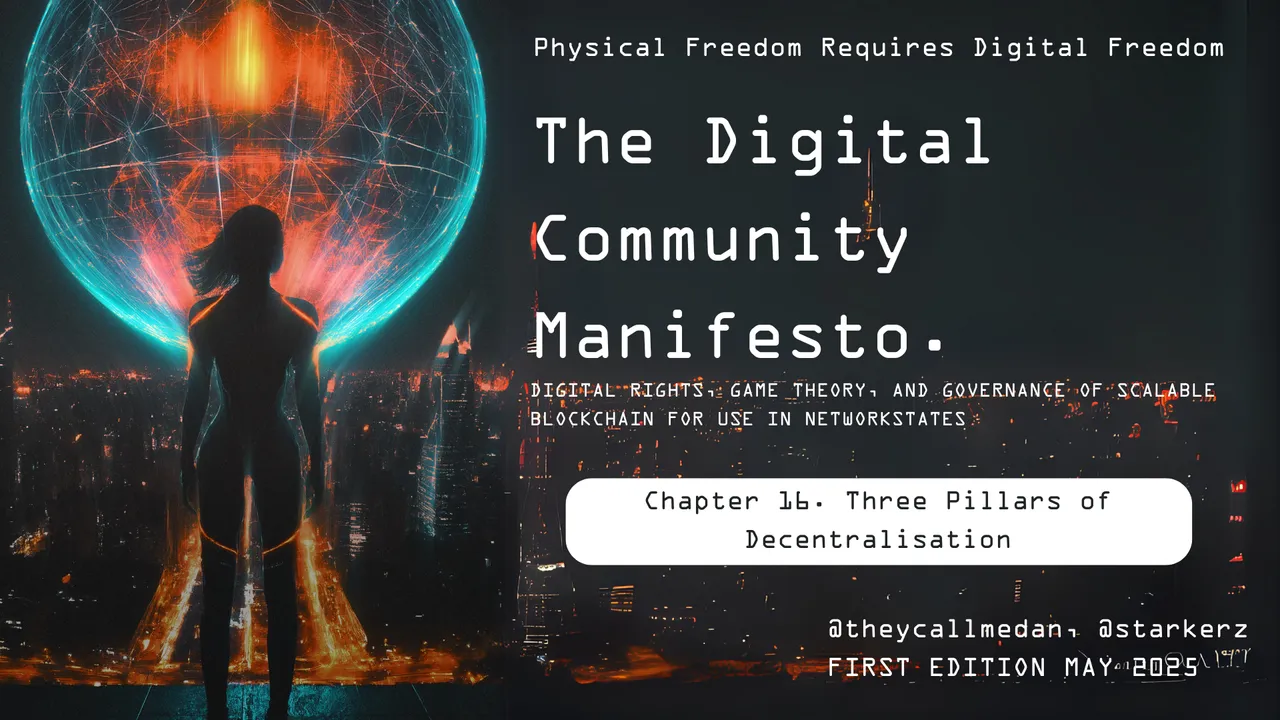Securing Digital Rights for Communities (Game Theory and Governance of Scalable Blockchains for Use in Digital Network States)
Chapter 16. Three Pillars of Decentralisation
Three Pillars that all digital communities need for self-sovereignty

Introduction
Many projects struggle with decentralisation because they focus on the wrong goals or mix too many complex features into their base layer. By contrast, truly censorship-resistant and scalable systems can emerge from three core pillars. When these pillars exist at the base layer, the entire ecosystem gains self-sovereignty, freedom of speech, and economic resilience.
16.1. Text-Based Data Availability
Freedom of Speech
A system must store text (or fundamental data) in a globally replicated way. This ensures everyone can freely post or read, without a single entity able to delete or block content.
Simplicity and Cost
Only storing text keeps overhead predictable and minimal. Complex computations or large file storage on the base layer lead to huge costs and limited scaling.
Neutral Infrastructure
Because text is universal and lightweight, it can be distributed across many jurisdictions. Attempts to censor or alter historical records fail unless the entire network agrees, ensuring true data availability.
Key Point: Text-based storage on the base Layer 1’s the foundation of free speech and collaboration across any border.
16.2. Zero-Fee Transaction Layer
Skin in the Game Instead of Fees
Rather than paying every time you transact, you stake (lock up) tokens to gain transaction bandwidth. This model is often called “resource credits” or “regenerative fees.” It eliminates unpredictable costs and fosters global usability for all people, whereas chains with fees on transactions can become prohibitively costly to people without economic means to pay such fees.
High Throughput, Low Friction
When you remove transaction fees, you open the door for real-time micropayments and rapid app development. Users do not abandon the network under surge pricing or fee spikes.
Expanding Ecosystems
Zero or near-zero fees make it viable to build truly decentralised applications (on Layer 2’s) that reference data from the base layer. Expensive layer 1’s cannot host decentralised apps effectively because each action that clears from layer 2 to layer 1 (so that the Layer 2 application gains trustless security) becomes too costly.
Key Point: A zero-fee transaction layer (backed by staking) ensures anyone can use the network, allowing broad adoption and preserving censorship resistance.
16.3. On-Chain Stablecoin
Essential for Daily Use
A stable form of payment is critical for real-world transactions. If the native token always fluctuates in value, most people will not rely on it for routine expenses, business transactions or savings.
Decentralised & Backed
An on-chain stablecoin can be algorithmically backed by the main governance token. As long as the stablecoin’s market cap remains well below that of the base token, the system remains secure.
Self-Sovereign Conversion
Because this stablecoin resides entirely on the base chain, users exchange value without external markets or centralised “gatekeepers.” True on-chain liquidity means no forced reliance on outside exchanges for dollars or stable value exchange. Essentially this means that the eco system can continue to function and provide itself with liquidity, without Centralised or even decentralised exchanges
Key Point: A decentralised stablecoin, fully integrated on the base layer, is the final piece that allows people worldwide to store and transact in stable value without leaving the protocol.
16.4 Why These Three Pillars Matter
Censorship Resistance
Text-based storage protects free speech. Distributed nodes ensure no single jurisdiction or entity can delete what you say, post, your followers, your community or its economy.Zero-Fee Transactions
With staked tokens, users bypass unpredictable network fees. This opens the door to everyday usage, micro-transactions, and diverse decentralised apps where users do not require gas, a prohibitive hurdle to access in order to interact with the ecosystem.Stablecoin Integration
People need a stable unit of account for commerce. An on-chain stablecoin allows real economic activity without centralised intermediaries.
Together, these pillars form a self-reinforcing network:
- Free Speech (data availability) increases the system’s inherent value and communication.
- Zero Fees encourage participation and app development for all people.
- A Base layer Stablecoin empowers real-world trade without needing external exchanges.
When combined, they create a truly self-sovereign ecosystem: no central point of failure, no single jurisdiction in control, resistant to blockages of on and off ramps, and no reliance on external stablecoins or exchanges. This model is already demonstrated in systems like The Hive Blockchain, which integrates text-based data, near-feeless transactions through staking, and an on-chain stablecoin. By mastering these three pillars, a blockchain can achieve a higher degree of decentralisation and practical everyday utility.